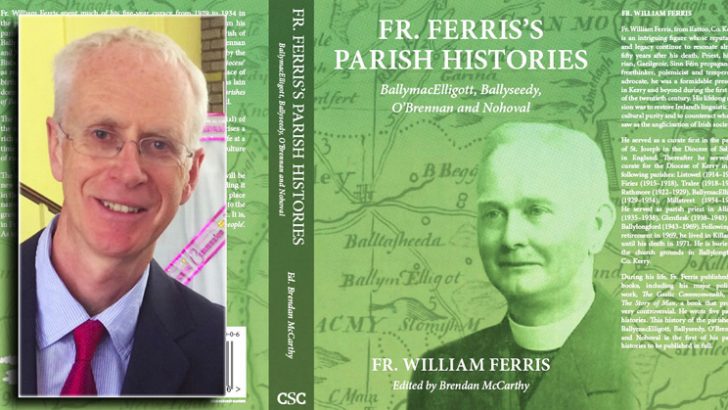The Notebook
Fr Bernard Healy
Recently Bishop Ray Browne of Kerry launched a book that was banned by one of his predecessors. The book – Fr. Ferris’s Parish Histories: BallymacElligott, Ballyseedy, O’Brennan and Nohoval – was ready for printing in 1932, but Bishop Michael O’Brien put a stop to its publication. The eponymous Fr William Ferris was a priest of the diocese, and the book itself was an anthology of the archaeology, history and traditions of Ballymacelligott gathered at station Masses during his time there as curate.
It seems strange that a parish history would fall foul of censorship. The problem was that Ferris claimed that St Brendan was born, not in the Fenit area as diocesan tradition held, but at O’Brennan in the parish of Ballymacelligott.
Publication
Fr Donal Reidy, the Bishop’s secretary, wrote to Ferris telling him that if he would correct that one point, nothing would stand in the way of publication. Ferris, however, was not a man to back down. As a nationalist curate in Tralee he had been threatened with assassination by the crown forces during the War of Independence.
After the Treaty, he then had the independence of mind to swim against republican opinion in Kerry by backing the Treaty and taking up a post as a Free State Army Chaplain. On the issue of St Brendan’s birthplace, Ferris would not compromise and his book was confined to oblivion for eight and a half decades.
Ironically enough, the Bishop’s secretary who wrote quashing the publication of the book would later put the saint’s home in Annagh on the other side of Tralee Bay to the official birthplace in Fenit. Ferris would sarcastically note that Reidy’s theory must have arisen through some kind of “private revelation”.
The recovery of Ferris’s book is due to the work of one Brendan McCarthy (www.ballymacelligott.com).
Whilst researching his own family history, he came across the manuscript in Tralee library and recognised a treasure trove that would be otherwise lost. As Fr Ferris himself noted: “Every time the wind blows from the east, it sweeps away with it forever some old seanchaí with his store of local traditions.”
As well as reviving these old traditions, the publication of this book allows for Ferris’s own memory to be revived. Ferris is worth recalling as a larger-than-life priest who turned his gifts towards the betterment of nation and Church, albeit with mixed results.
Quite apart from gathering parish folklore, he also wrote on political and religious matters. Sometimes he was prophetic – he anticipated the intellectual atmosphere of the Second Vatican Council and the need for Parish Pastoral Centres as early as the 1940s. In the 1920s he could see the troubles inherent in both the political right and left.
However, his ideas for how Ireland might steer a middle course between the extremes of capitalism and communism and develop a unique form of government were quixotic in the extreme – he proposed a state where most government is local and voluntary with each parish looking after its own roads and railways.
He suggested the state be defended by a sort of citizens’ militia with coastal communities fundraising amongst themselves for the purchase of submarines.
In Ferris’s Ireland not only the clergy, but also the legal and medical professions would be bound to celibacy. (He held a prejudice that the sons of doctors were especially prone to dissolute living!)
A story is told of Fr Ferris’s legendary foresightedness. At some stage in the 1960s, he put a call through to the ESB depot in Tralee asking to speak to “one of the top engineers”. Assuming that there was an electrical fault at his presbytery in Ballylongford a repair van was dispatched post-haste. Fr Ferris met the workmen and invited them in for refreshments and a chat.
After a while, the workmen asked him what needed fixing. Nothing needed fixing, Ferris explained. The depot had got the wrong end of the stick. He wanted to speak with a “top engineer” to discuss with him how the ESB might “harness the power of the waves”. The ESB men drove back to Tralee, greatly amused by this curious cleric and his idea of making electricity from the sea. It was only decades later when wave-power technology became a reality that they recognised Ferris’s spark of genius.


 Bishop Ray Browne (left) and cover of Fr William Ferris' book
Bishop Ray Browne (left) and cover of Fr William Ferris' book